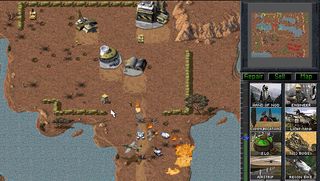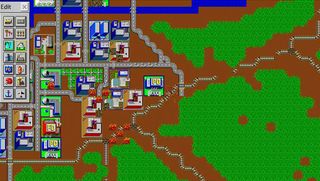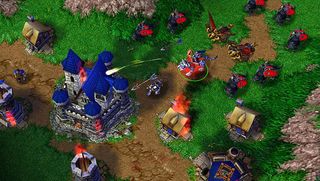41. Gears of War (2006)

If you've played a third-person shooter since 2006, there's a good chance that it lifted features wholesale from Gears of War. Besides arguably being responsible for the influx of gritty grey/brown shooters that flooded the market, it also included the best cover system to date. Though some other games' cover system predate Gears' (Kill.Switch is often credited as the first real "cover shooter"), none had as large of an impact on the industry.
It's not just the inclusion of being able to hit a button to hide behind an object that makes Gears so influential. Epic Games built Gears around the cover system, creating the stop-and-pop style of gameplay that became popular in the years since. Because of Gears, third-person shooters need cover, just like first-person shooters needed the ability to look up. It changed the genre entirely, and it's gotten to the point where not being able to find cover in a third-person game makes it feel like a handicap.
40. Starsiege: Tribes (1998)

Quake III and Unreal might get most of the plaudits for popularizing the fast-paced, physics-driven future shooter arena experience, but Tribes got there first, with gameplay mechanics that modern shooters are still catching up to. If you ever wondered why Halo put jetpacks in Reach, Tribes is why.
Built solely around organized team games over huge cross-country maps, Tribes' real attractions are its standard use of rocket boosters for wide-ranging aerial combat. Its now-iconic skiing exploit, a physics trick which allowed smart players to accrue immense acceleration, unlocked vast high-flying potential for skilled players. It was amazing then, and the series' resurgence in 2012's Tribes: Ascend proved that there's still nothing else like it now.
39. Command & Conquer (1995)

The Command & Conquer name still raises eyebrows, but its all down to the impact the original had, making real-time strategy gaming an exciting thing to play. It felt strange to many at the time, as you didnt take direct control of the characters, instead ordering them around en masse.
C&C brought the idea of funding units with gathered resources to the forefront of gaming, requiring gamers to plan how they were going to play for the next 20 minutes or so, instead of simply reacting to second-by-second action. The original is impeccably designed, fiendishly addictive, and uncluttered by progressive ideas, making it plain to see why it was so influential.
38. SimCity (1989)

OK, so the SimCity name is currently dirt, thanks to the controversial always online model adopted by SimCity 2013. But that shouldnt detract from the fact that the first game popularized the entire simulation genre. Back in 1989, SimCity felt completely liberating, offering players the chance to design and build their own metropolis, micromanaging aspects of the process that seemed incredibly detailed at the time.
If it wasnt for SimCity, its unlikely that wed have played games like Civilization, Total War, or even The Sims. It even provided the template for massive mobile hits like Tiny Tower and Pixel People--games that are mere months old--demonstrating SimCitys incredible strength of concept.
37. Warcraft III: Reign of Chaos (2002)

Warcraft III was more than an amazing real-time strategy title, more than a classic story of a fallen hero, and more than a significant player in the competitive online gaming realm (though, all those things could almost qualify its existence on this list). The reason Warcraft III belongs among the most important games is because it gave birth to the MOBA (multiplayer online battle arena), an entire genre of games.
Sharing map creations and coming up with wacky games in the Warcraft III map editor was all the rage back in the day. But eventually, Defense of the Ancients came out into the wild and the tower defense game launched a new kind of competitive gaming experience. After DotA, other developers started their own MOBAs resulting in games like Demigod, and Riot Games' League of Legends.
36. Shenmue (1999)

Shenmue simultaneously typified everything that made Sega great and everything that made it fail as a platform holder. Yu Suzukis vision for an RPG based on Virtua was so ambitious that it demonstrated how the companys entire hardware business was unsustainable. Every Dreamcast owner would famously have needed to buy two copies of the game just for it to break even after its $47 million dollar development.
It didnt happen--leaving us with two sensational games but no closure on one of gamings most well-known stories. As a major contributing factor for one of the old big three leaving the console market, it is an infamous yet essential part of gamings history.
35. Myst (1993)

It may have been a good-looking but fiendishly difficult point-and-click adventure, but Myst changed the way games told stories. Instead of pushing players down a linear path, feeding them the narrative in an orderly fashion, Myst bounced us around time and space asking us to fill in the plot based on clues dotted throughout the world.
So, did you enjoy BioShock Infinite recently? How did games like Skyrim and Fallout work out for you? All good? Yup, they all owe a huge debt to Mysts pioneering, non-linear storytelling. Oh, and lets not forget Mysts important contribution to popularizing gaming as a hobby--its impressive sales were a big reason that the CD-ROM format became as popular as it did, back in the early '90s.
34. Metroid (1986)

Samus' plunge into the depths of the planet Zebes is one of the most beloved game experiences of all time. As opposed to the 2D side-scrollers of its age, Samus didn't just move from the left of the screen to the right to beat a level, kill a boss, and call it a day. Instead, she could explore rooms in every direction, and every new item she collected unlocked previously unreachable locations.
There has been an entire gaming genre named for the Metroid-style gameplay. Although the term "Metroidvania" refers to both Metroid and Castlevania: Symphony of the Night, it was Samus who first blazed the trail. In the original Metroid there were no levels, just one giant world and a whole lot of locked doors. But the keys to those barriers were the items and weapons you found throughout the adventure. Exploration was essential, and retreading old ground with a new upgrade in hand was often the way to ultimately move forward. Many adventure titles still use the gameplay elements Metroid founded decades ago, and without this pioneer, todays adventure games would be very, very different.
33. League of Legends (2009)

Free-to-play gaming is nothing new, but for a long time the market was mostly filled with browser-based MMOs made specifically to strip you of your cash. League of Legends changed that perception, proving that there was more to F2P than pay-to-win--something it proved when League of Legends went from popular online game to worldwide eSports phenomenon.
Since LoL's release, dozens of games have copied its monetization strategy, focusing on customization and convenience instead of allowing players to buy their way to the top. And it's working. The fire has been lit, gaming is changing, and League of Legends--with 32 million registered players--is holding the matches.
32. Minecraft (2011)

On sale for two and a half years before its official, completed release, Minecraft's paid-for Alpha and Beta versions (along with free updates for all buyers of the pre-Beta versions) managed to create an immensely engaged, vocal community that built simmering viral hype right up to the game's eventual release. Players felt involved and valued, while non-players felt damnably intrigued as to what all the fuss was about. And so, seemingly overnight, Minecraft became huge.
Not just huge for an indie game, or huge for a downloadable game, or huge for a PC game--huge overall. So big that Hot Topic has a section dedicated to Minecraft shirts. So big that it has its own convention. So big that it created its own genre. Minecraft proved, once and for all, that a game made by a handful of people for barely any money could compete with the biggest AAA games around.

